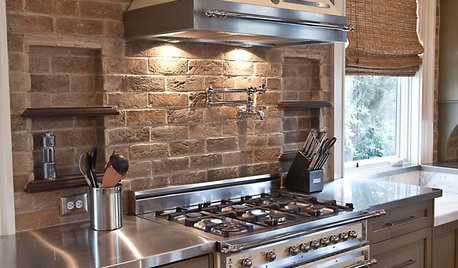is sauce that has some olive oil in it able to be canned?
masi61
16 years ago
Featured Answer
Sort by:Oldest
Comments (25)
ksrogers
16 years agojenniesue
16 years agoRelated Discussions
New olive trees- making homemade olive oil?
Comments (5)Not sure where you are, but there are olive presses scattered throughout California. You go there with your load, and they will give you the oil (and keep the pomace as well as some of your money). An olive press is much more complex and expensive than an apple press. It will be 10 years before you are up to 30-40 lbs of olives per tree per year (and those 100 lbs will give you only 10-20 lbs of oil, which is very little. My family of three uses 30-35 lbs a year. If you do the pressing yourself, you may only get 5-10 lbs). In the intervening time, I would just eat some fresh (fresh olives fried with a drop of oil and salt are wonderful, and not bitter at all while hot), freeze some (they are great in all sorts of stews and braised meates) and cure most of them. Middle Eastern friends do the curing in their bathtub. For bigger crops, water in May through July, but withhold water later....See MoreNcfhp Spaghetti Sauce Without Meat.....uses oil??
Comments (14)Oh you bet Carol!! Beans is one of those things I am waiting till winter for, as I will have to buy them in the store anyway. How did you read my mind?! :-) I have frozen at least 100 pounds of blanched, seeded tomatoes for fall projects as well. Dehydrating herbs is a winter project with herbs I'll be growing in the greenhouse. I am not opposed to buying produce and canning it at home, no matter the price, for the experience. Everytime I do it, I learn and improve. In the past 20 years, I would purchase commercial flower seed year round, and grow many plants under grow lights in my home. When I say grow lights, I mean at one point and time I had 65 shop lights in my attic rooms. I would grow plants from seed to flower, and the plants never made it into the garden, because I would throw them out and start all over again. For the experience, practice, and skill. I would do this year round and I cannot tell you where I would be had I not done so. Years later, the greenhouse was built, and the rest is history. When I want to do something, nothing stops me. But doing things correctly slows down "gung ho" determination when it comes to food safety. Perfect practice makes perfect.........See MoreProbably OT...Olive oil bottle/drizzler question
Comments (54)rhome, I forgot you were cooking several batches - I probably would add a little more for each batch - depends on whether the wok looked oily or not. If not, then I'd add a little. Someone here, I'm afraid I don't know who, recommended "Breath of a Wok" and I got a copy for Christmas. Really helpful about technique, wok types and styles etc. Interestingly, the author makes it pretty clear that the inexpensive carbon steel woks are the best. I just heat mine until the oil begins to smoke a little. I've never timed it. I use Sclafani extra virgin olive oil. They are a local importer, in CT, and have been in the forefront of a campaign against 'adulterated' olive oils. The consumption of olive oil worldwide has skyrocketed, and the entire production of Italy cannot now possibly account for the amount being sold as "Italian". So CT is now testing oils, and discovered that several are only 10% olive oil, and the balance is groundnut oil - which is pretty serious for those with allergies. So, I'm confident with Sclafani, and their quality and flavour....See Morehas anyone had success canning their mole sauce?
Comments (3)Recipes for it vary greatly but most all of them contain ingredients that cannot be safely canned at home - even with a pressure canner. The guidelines severely restrict canning anything with oils and fats because they insulate any bacteria and prevent the heat from killing them. That lets out the chocolate, the nuts, the lard or olive oil, etc. Not to mention all the low-acid ingredients in it with no added acid of any kind in the recipe. So canning it is purely a "at your own risk" thing and no tested processing method or length of time is available. The USDA approved recommendation for it is freezing only. Dave...See Moredavid52 Zone 6
16 years agomasi61
16 years agoreadinglady
16 years agodavid52 Zone 6
16 years agodigdirt2
16 years agodavid52 Zone 6
16 years agokayskats
16 years agoksrogers
16 years agoreadinglady
16 years agodavid52 Zone 6
16 years agodigdirt2
16 years agoreadinglady
16 years agodavid52 Zone 6
16 years agoreadinglady
16 years agodavid52 Zone 6
16 years agodigdirt2
16 years agoreadinglady
16 years agoksrogers
16 years agodavid52 Zone 6
16 years agoreadinglady
16 years agoksrogers
16 years agoGary Austin
last year
Related Stories

LIFEHouzz Call: What Has Mom Taught You About Making a Home?
Whether your mother taught you to cook and clean or how to order takeout and let messes be, we'd like to hear about it
Full Story
MY HOUZZA Light-Filled Artist’s Loft Has Touches of Home
A painter finds the perfect studio space in Seattle’s vibrant Ballard neighborhood
Full Story
KIDS’ SPACESWho Says a Dining Room Has to Be a Dining Room?
Chucking the builder’s floor plan, a family reassigns rooms to work better for their needs
Full Story
CONTEMPORARY HOMESHouzz Tour: Family Has Room to Spare in New Rural Home
A builder and his wife design a streamlined house for their family that embraces the land and shows careful planning
Full Story
PETSWhat Chihuahuas Can Teach Us About Interior Design
Who knew these tiny dogs could be such a huge fount of design tips? Houzzers did
Full Story
KITCHEN DESIGNYes, You Can Use Brick in the Kitchen
Quell your fears of cooking splashes, cleaning nightmares and dust with these tips from the pros
Full Story
KITCHEN DESIGNThe Cure for Houzz Envy: Kitchen Touches Anyone Can Do
Take your kitchen up a notch even if it will never reach top-of-the-line, with these cheap and easy decorating ideas
Full Story
KITCHEN DESIGNHow to Lose Some of Your Upper Kitchen Cabinets
Lovely views, display-worthy objects and dramatic backsplashes are just some of the reasons to consider getting out the sledgehammer
Full Story
HOUSEKEEPINGLower Your Heating Bills With Some Simple Weather Stripping
Plug the holes in your house this winter to make sure cold air stays where it belongs: outside
Full Story
GREEN BUILDINGLet’s Clear Up Some Confusion About Solar Panels
Different panel types do different things. If you want solar energy for your home, get the basics here first
Full Story


jenniesue